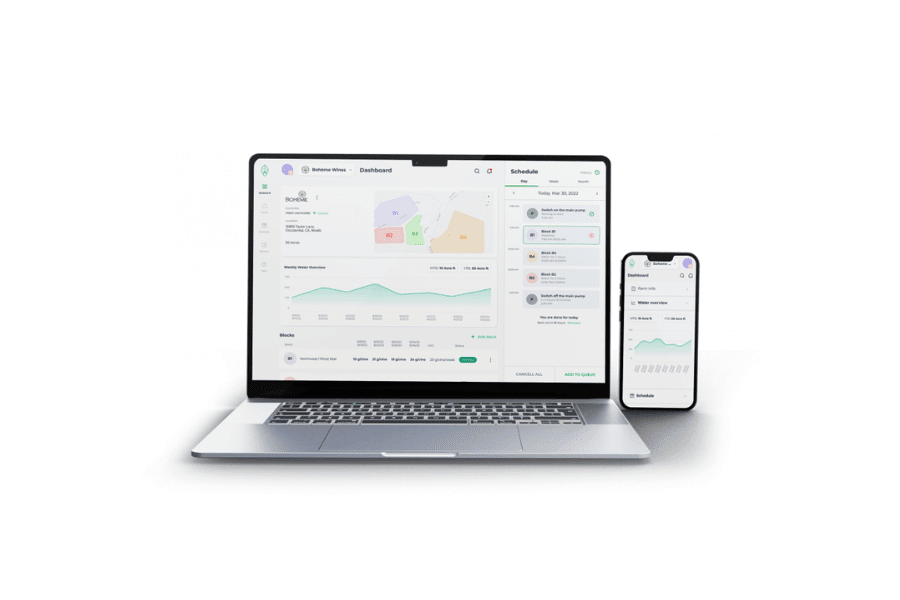Cloud-Managed Irrigation: Better for Business, Precision Farming, and Water Conservation

What is Cloud-Managed Irrigation?
No, we’re not talking about storm clouds. While we wish we had Thor, God of Thunder, on speed dial, he’s a little too busy to be able to open up the skies over blocks 2, 5, and 9 on an 80 acre ranch on command.
The “cloud” we’re talking about refers to software and databases on servers that are accessed via the internet.
Cloud-managed irrigation is a one-two punch that offers irrigation control, monitoring and data visualization. That means you can schedule irrigations from your couch (while watching a Thor movie, perhaps) or open and close valves in real time using nothing but a smartphone or laptop. Then, you can review feedback from sensors within your system so that you know exactly how much water made its way from your pump to your plants and rest assured knowing that the water is flowing as intended
Efficiency, Efficiency, Efficiency
No matter how you slice it, cloud-managed irrigation makes farming more efficient. From reduced labor hours and costs to more precise irrigation and better data, a cloud-managed system pays off in the long term.
The Irrigation Evolution
The earliest archaeological evidence of irrigation dates to about 6000 BCE in the Jordan Valley of the Middle East. Irrigation has given rise to civilizations, and contributed to their downfall through misunderstood factors like salt management and drainage.
Irrigation systems have come a long way since, especially in the last half-century of technological innovation. Drip irrigation, developed in Israel in the 1960s, is now commonplace, and farmers can implement systems that allow for block-specific control. Some modern systems are extremely complex, even on small tracts of farmland. That’s a good thing, particularly for more finicky crops, like wine grapes.
But more complex systems mean more valves. Those valves need to be turned on and off. For most, that requires manually turning valves in the field. Depending on the size of the area being irrigated, the number of blocks, and the frequency and duration of irrigation, that adds up to a lot of labor hours over the course of the growing season.
Reducing Labor Hours
Cloud-managed irrigation removes the labor hours spent turning valves without removing human decision making and control. You and your team can spend more time focusing on other important activities, like watching action-packed superhero movies (we won’t tell), or you know, weeding and pruning.
The reality is that dwindling farm labor supply makes reducing labor hours a necessity. In a 2019 survey of California farmers conducted by the California Farm Bureau Federation in collaboration with the University of California, Davis, 56 percent of respondents reported that they were not able to hire the number of workers they desired in the last five years.
Labor scarcity is driving the cost of agricultural labor up in a more competitive market. Nearly 75 percent of farmers said they have turned to labor-saving technology as a result of rising labor costs. By reducing labor hours, cloud-managed irrigation helps reduce labor costs.
More Precise Irrigation Yields Better Crops and Conserves Water
With 24/7 control of your irrigation system at your fingertips, cloud-managed irrigation allows you to operate without the constraints of boots on the ground. If you’d like to irrigate at night to conserve water through reduced evaporation, for instance, just schedule it ahead of time and let the cloud-based system do the work for you. You don’t have to worry about finding someone to go turn valves at midnight.
Plus, we all make mistakes. That’s what makes us human. Not even Thor can always be precise. But in the field, a mistake like forgetting to turn off a valve can waste thousands of gallons of water and may harm the quality of your crop. With cloud-managed irrigation, you can schedule an irrigation for an exact duration at specific times, removing the margin of error. Sensors built into your system will confirm that water was not only pumped from your reservoir or well, but that a specific amount of water was delivered to certain locations at exact times. For example, instead of “guesstimating” that running your irrigation for 6 hours will deliver 6 gallons of water per vine, the sensors will detect when exactly 6 gallons have been used and shut the system off. This eliminates variances caused by low pressure or other anomalies that you may not account for.
Data Visualization Builds a Roadmap for Future Farming
The beauty of an integrated cloud-managed system is that all of this data remains available to you. Gone are the days of logging irrigations manually and estimating water use. If you want to visualize your irrigation history or examine your system for errors, it’s all stored on the cloud. No need to enter your data into a spreadsheet and create your own charts and graphs. From the cloud, you can populate the data you want, set parameters, and voilà! Your reports are generated for you.
Cross reference with additional data, like soil moisture, temperature, humidity, wind, and solar radiation, and suddenly you’ll have a much bigger picture of your input and output within the agricultural ecosystem. Use that to grow better crops, save money, and conserve water. The future requires it.
To learn more about cloud-managed irrigation, contact us here, request a demo or email us at [email protected]